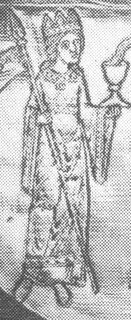A few more pictures from Davenport's "Book of Costume"":

"Foolish virgins" School of Metz, 12thC German. MS78A4 (Berlin State Museum)
- Davenport says they are wearing byzantine fashion. I think it looks rather more like byzantine influenced fashion. The parable gives no clear clues why they should be wearing byzantine dress, rather than local fashion. As these are the foolish virgins, one expects them to be fashion victims, with the most faddish fashions - as evidenced by the impractical loose hair.
- Note several of the dresses have repeated marks on them. This could be meant as patterning or bezants, but I wouldn't want to rely on that. The saintly figure shown above them in the complete picture (not shown) wears a fully patterned fabric with patterned trim. So they could draw it so, although it might not have worked compositionally.


Next, a few pictures from "The year 1200: volume II A background survey" Published in conjunction with the Centennial Exhibition at the metropolitan Museum of Art February 12 through may 10, 1970. Metropolitan Museum of Art (new york) editor: Florens Deuchler
article in book: Wixom, W, D, "The greatness of the So-Called Minor arts" p93-132
9.Paten of the Tremessen Chalice, Lower Saxony, about 1180 (Tremessen, Poland, abbey church.)
- Seems to be some kind of seasonal theme, surrounding a crucifixion scene. The two pictured are supporters at the Crucifixion. You can just see their shorter tunic hems. I'm not positive the first figure is female, but I think so.
Another one from Dodwell:

"Frontispiece to the books of Solomon", a Bible, ms2456 f13. Tuscany, Italy, 3rd quarter 12thC (Museo Diocesano, Trento)
- Umbro-Roman style - ie heavy byzantine influence, with some Italian moderation.
- so the style is present in italy too
I'm almost certain the pair from Lower Saxony are Ecclesia (on the left -- so yes, it is a woman) and Synagoga. They're allegorical figures.
ReplyDeleteI'm doing a study of Jewish women's dress in 12th century Germany and will post a link soon.
Thanks for all the great information and pictures you post! This is the first 12th c. Synagoga I've seen.
Raina